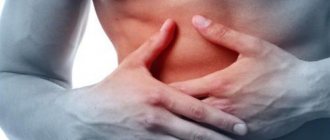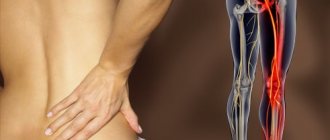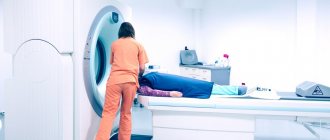Treatment tactics for spinal stenosis can be conservative (without surgery), interventional or surgical. Stenosis
is a chronic degenerative process in which the intervertebral foramen, central spinal canal, or lateral recess gradually narrows.
Ultimately, this leads to compression (squeezing) of the spinal cord roots and nerve endings. The patient experiences severe pain in the back or neck, numbness and weakness of the limbs, and other neurological symptoms listed below. The disease progresses due to the fact that fragments of growing cartilage or bone tissue (osteophytes) and hypertrophied soft tissue (ligaments and muscles) wedge into the space occupied by the nerve roots.
Degenerative spinal stenosis is caused by injuries, genetics, metabolic disorders, osteochondrosis, arthrosis or other diseases of the musculoskeletal system. In the initial stages of the degenerative cascade, symptoms of spinal stenosis may not bother you at all. However, if the situation worsens over time, then it is no longer possible to cure the disease without surgery. Removal of stenosis is possible only surgically. In this case, non-traumatic spinal surgeries are performed to decompress (and sometimes stabilize) the deformed segment.
Relative stenosis
The central spinal canal narrows to 12-10 mm.
Treatment of relative stenosis without surgery often gives good results.
The patient is prescribed complex therapy, which includes medications (NSAIDs, NSAIDs), physiotherapy, and exercise therapy. In our clinic, specialists from the Pain Treatment Center will help you choose an effective treatment strategy for central relative stenosis. Don't put off seeing a doctor. Degenerative stenosis does not go away on its own. Over time, the disease worsens and at the next stage causes back or neck pain, and sometimes also neurogenic intermittent claudication syndrome (for example, with lumbar stenosis L3, L4, L5
), paralysis of the limbs.
Complications of spinal canal stenosis
The main danger of primary stenosis is dysfunction of the respiratory system, which is observed against the background of compression of the spinal roots. Shallow breathing may be replaced by attacks of suffocation, which sometimes goes away on its own. But such situations are extremely dangerous for human life, so it is better not to take risks and immediately seek medical help.
Also, as a result of the narrowing of the canal, a change in the quality of nutrition of the spinal cord and brain is observed, since formations protruding into its lumen can compress the vertebral arteries, as well as other blood vessels. In such situations, surges in blood pressure may occur, which can lead to ischemic areas in the brain and stroke.
Other complications of such conditions include:
- brain hypoxia;
- massive swelling;
- poor circulation throughout the body;
- development of deviations in the functioning of internal organs;
- changes in the tissues surrounding the spinal canal.
Such complications do not pose such a threat to life as respiratory failure or ischemia of brain tissue, but they can significantly reduce a person’s quality of life and ultimately lead to extremely severe and sometimes fatal consequences. Therefore, it is important not to neglect the existing symptoms of the disease, but to immediately consult a doctor in order to diagnose the causes of their occurrence and prescribe treatment appropriate to the situation.
Absolute stenosis
The central spinal canal narrows to 10 mm or less. Treatment of absolute stenosis with conservative methods sometimes no longer gives the desired effect. At this stage, pain in the limbs becomes a serious obstacle to an active life. Especially if the patient has neurological symptoms: pain radiates to the legs and hips, there is a feeling of muscle weakness, and the sensitivity of the limbs decreases. Unlike relative stenosis, absolute stenosis is characterized by pronounced clinical symptoms and may be an indication for spinal surgery. Expansion of the central spinal canal by surgery may be most appropriate, since there is a serious risk of complications without surgery. For example, irreversible paralysis of the limbs, which occurs due to vascular ischemia and circulatory disorders in the spinal root.
Causes of occurrence and development
Before starting treatment for lumbar or cervical spinal stenosis, you should find out what causes the onset and development of the disease.
A congenital or primary type of stenosis is formed during the intrauterine development of the human embryo. This happens in the period from 3 to 6 weeks of development. The genetic factor plays a role here. But absolute spinal canal stenosis can also develop due to infectious, toxic factors that affect the fetus.
Also the cause of congenital stenosis is:
- chondrodystrophy or achondroplasia (chronic). This manifests itself in intrauterine bone growth disorder. In this case, the spinal canal narrows due to shortening or thickening of the vertebral arches, fusion of the vertebrae themselves;
- Diastematomyelia. It is characterized by bifurcation of the spinal cord, separation of the spinal canal by a septum (it consists of either bone or cartilage tissue).
Secondary spinal stenosis appears and develops in childhood or in adulthood.
The following reasons may contribute to this:
- traumatic displacement of the vertebrae or intracanal hematomas;
- changes in the intervertebral joints, which manifest themselves in the growth of bone tissue inside the spinal canal. These changes are degenerative-dystrophic in nature;
- anatomical defect of the spinal arch;
- intervertebral hernia;
- inflammation in ankylosing spondylitis (in this case, the capsules of the intervertebral joints thicken);
- Forestier's disease;
- cysts and tumors that appear inside the spinal canal.
Regardless of the cause, treatment for spinal stenosis should begin as soon as the disease is detected.
Lumbar stenosis
An extremely common type of degenerative stenosis, which is diagnosed in 85-90% of cases. Symptoms significantly reduce the patient’s quality of life, since lumbar stenosis is characterized not only by pain in the back and lower back, but also in the limbs. Very often manifests itself as a syndrome of neurogenic intermittent claudication. The patient feels weakness, numbness and pain in the legs. It is important to understand that paresis of the limbs is completely reversible only with timely treatment. The most common clinical cases include L3 - L4 or L5 - L4 stenosis (low back pain radiating to the leg). Another common variant is L5-S1 spinal canal stenosis. At this level, the lumbar region passes into the sacral region, that is, it is a fairly mobile and susceptible to load segment. With lumbar stenosis L5 - S1, the patient also suffers from pain that “radiates” to the legs.
If there are indications for surgery for lumbar stenosis, neurosurgeons at the Pirogov Clinic perform them using the latest endoscopic technology or microsurgical instruments. This eliminates the need for additional installation of implants and metal structures. Thus, patients recover in a short time - without heavy rehabilitation.
Prevention
There are no specific measures for spinal stenosis. Among the general activities we can recommend:
- A lifestyle with systematic sufficient and adequate physical activity, including morning exercises, walking, swimming, and sports games.
- Avoid dynamic/static overloads of the spinal column.
- Maintaining hygiene/proper organization of work and sleeping space.
- Timely diagnosis of the condition of the spinal column and, if necessary, correction/treatment of changes (weight loss, wearing a corset, exercise therapy, wearing a corset).
Cervical stenosis
Less common than lumbar stenosis. However, due to the high mobility of the segment and its comparative fragility, spinal surgery (endoscopic or microsurgical) may require additional installation of an intervertebral disc implant or interbody cage. This is necessary to stabilize the spinal segment and prevent the development of degenerative complications in the future. With cervical stenosis, local pain occurs, radiating to the arms and atrophy of the muscles of the upper extremities. Neurosurgeons at the Pirogov Clinic prefer minimally invasive endoscopic operations and interventional pain treatment, which avoid traumatic operations with the installation of metal structures.
If you have been diagnosed with cervical stenosis and have been experiencing pain that is resistant to conservative therapy for more than 12 weeks, send the images to your neurosurgeon through a special form on our website to clarify which treatment would be most appropriate in your case.
Treatment
Conservative treatment of absolute stenosis is not used. It is ineffective due to the rapidly deteriorating condition of the patient. Self-administration of painkillers and ointments by patients is contraindicated, as this further aggravates the situation. The person does not feel pain, but pathological processes continue to progress .
Surgical treatment of the disease involves the use of the following types of operations:
- Decompressive laminectomy.
- Installation of vertebral stabilization systems.
- Application of interspinous fixation.
Decompression laminectomy
This method has been used since the days of Henk Wibster. It consists of removing those structures that cause compression . That is, resection of the spinous processes, vertebral arches, and affected joints is performed.
Laminectomy is used if severe compression of the spinal cord occurs
However, this type of intervention has a number of significant disadvantages. Namely, the removed structures constitute the third supporting column of the spine, and their resection leads to the development of instability. According to statistics, instability occurs in 45% of those operated on. In addition, the operation is performed using a posterior approach, in which the complication rate reaches 12.
If the cause of the stenosis is a hernia, then it is possible to perform a disectomy , that is, complete removal of the disc followed by its replacement with an implant.
Installation of stabilizing systems
Stabilizing operations are used as independent treatment or as a complement to laminectomy .
Recently, minimally invasive operations with access through small incisions have been used. Spinal stabilization as a method has a number of advantages, but is not without its disadvantages. When installing mechanisms, neighboring vertebrae are damaged, as a result, their mobility increases and related pathologies develop: spondylolisthesis, scoliosis.
Interspinous fixation
With stenosis, the load is redistributed from the anterior spinal support to the posterior one. Installation of clamps reduces the load on the posterior support and expands the lumen of the spinal canal .
The operation is performed through small incisions under microscope control. First, posterior decompression is performed, then an implant is inserted into the interspinous space. This preserves the possibility of flexion and extension of the spine.
Interspinous fixation allows you to distribute the load on the vertebrae
A positive outcome of the operation can be achieved in 85% of cases. At the same time, related diseases do not develop. The load on the joints is also reduced, the spine relaxes, and pain disappears.
Such operations are contraindicated in cases of vertebral instability , since the effect of the intervention is insufficient. In this case, it is advisable to use stabilizing operations. If stenosis has developed as a result of a vertebral hernia, then the optimal therapy is microdisectomy, which involves resection of the bone structure that caused the narrowing of the canal.
Rehabilitation
The most important stage of treatment is postoperative rehabilitation. Be sure to wear a support corset . Physiotherapy procedures are also required: ultrasound, electrical stimulation.
At the late rehabilitation stage, physical therapy and massage are included. Patients who have undergone surgery are recommended to undergo annual spa treatment. These activities are aimed at strengthening muscles, normalizing metabolism and preventing relapse.
Symptoms of spinal stenosis
- Pathological compression of the nerve roots, which leads to their ischemia, causes specific symptoms of spinal stenosis:
- Back pain that occurs when walking and radiates to the legs (legs, front or back of the thigh);
- Numbness and discomfort in the legs occur with a certain position of the spine (bending the torso, walking down the stairs, prolonged static standing position);
- Back pain becomes less intense or disappears altogether with a certain position of the spine (for example, if the patient is sitting, bending or squatting);
- Muscle weakness, numbness and decreased sensitivity of the limbs are especially noticeable after physical activity;
- Problems with urination and bowel movements;
- Problems with potency and erectile dysfunction.
- If, along with severe pain and paresis of the limbs, the patient experiences the last 2 symptoms, emergency spinal surgery may be necessary.
MRI images BEFORE
and
AFTER
surgery for foraminal spinal stenosis using the endoscopic method.
The roots are marked in red (dots and lines). Blue color shows the bone-ligamentous structures that compress the root. The green arrow, as well as the white color in the pictures, shows the free space for the spine. The goal of the operation has been achieved! Endoscopic decompression was performed by a neurosurgeon, a doctor of the highest category, candidate of medical sciences. Sciences Meredzhi Amir Muratovich
.
Classification
The classification of spinal stenosis is based on a number of signs, according to which the following are distinguished:
- Primary and secondary stenosis of the spinal canal. Primary stenosis is caused by congenital pathology (underdevelopment) of the vertebral foramen, manifested by shortening of the vertebral arch, fibrous/cartilaginous diastematomyelia and achondroplasia (decreased vertebral body height/increased arch thickness/shortened pedicle), while secondary spinal stenosis (acquired) develops as a result of various diseases spinal column ( deforming spondyloarthrosis , occurring with the formation of marginal osteophytes/hypertrophy of intervertebral joints, ossification / hypertrophy of the ligamentum flavum , degenerative spondylolisthesis , ankylosing , ossified herniated intervertebral discs, Forestier disease , postoperative scars/subarachnoid adhesions, etc.).
- According to anatomical criteria, central stenosis , manifested by a decrease in the anteroposterior size of the spinal canal, which occurs due to the development of pathological processes in the anatomical processes that directly form the spinal canal (intervertebral joints/discs, posterior longitudinal and yellow ligaments) and lateral stenosis - narrowing of the intervertebral foramen, developing as a result of hypertrophy of the superior articular process, peculiarities of the formation of the facet joint, the development of osteophytes localized at the site of attachment of the yellow ligament (foraminal stenosis). In turn, lateral stenosis is divided into “middle zone stenosis”, “entry zone stenosis” and “exit zone stenosis” of the nerve root from the intervertebral foramen.
- Relative and absolute spinal stenosis.
Diagnosis of stenosis
You should not guess about the disease based on the symptoms. Diagnosis of spinal canal stenosis is only possible using MRI results. The quality of the images must be at least 1.5 Tesla so that the doctor can accurately determine the specifics of the degenerative change, its location, and then prescribe effective treatment. The patient is also prescribed a survey spondylography with functional tests, which allows one to determine the mobility of the cervical, thoracic or lumbar segment. If there is a possibility of facet syndrome, CT and selective blockade of intervertebral joints may be additionally prescribed. If there are indications for spinal surgery or interventional pain treatment, diagnosis and treatment tactics are prescribed individually, depending on the clinical picture.
Pathogenesis
The narrowing of the spinal canal is based on changes of various types: thickening of the spinal ligaments, arthrosis of the facet joints , thickening of the bone, slipping of the vertebrae, etc. The pathophysiological mechanisms of neurological symptoms are caused by a combination of three groups of factors: increased pressure in the epidural space, ischemia and aseptic inflammation , each of which develops under the influence of chronic compression of the vascular/nervous structures of the spinal canal.
In the presence of prolonged compression, the blood supply to the nerve structures suffers, since the amount of blood flow does not correspond to current needs. Developing against the background of a decrease in the amount of incoming blood, ischemia of the nerve root contributes to the development of demyelination , the formation of adhesions between the paranoid and soft membranes of the spinal cord, as well as the development of interstitial fibrosis / cicatricial adhesive epiduritis .
The specificity of the pathogenesis of lumbar spinal stenosis is the pronounced dependence of the volume of the spinal canal on the position of the body: thus, at the time of squatting, the lumbar lordosis becomes kyphotic/straightened, and the articular processes diverge and the lumen of the intervertebral foramen increases, thereby freeing the blood vessels that are under compression, which contributes to normalization blood flow and nutrition of ischemic neural roots. When the spine is flexed, the height of the intervertebral foramen increases by 12%, while during extension it decreases by 15%, which explains the regression of pain when sitting down/bending the body.
Surgery for spinal stenosis
Doctors at the Pirogov Clinic treat degenerative stenoses both conservatively and surgically. All spine surgeries are performed using the latest endoscopic or microsurgical technology, as well as X-ray or radiofrequency equipment.
In most cases, preference is given to endoscopic operations for spinal stenosis
. They allow you to avoid the installation of implants - with the exception of cervical stenosis and cases where spondylolisthesis and instability of the spinal segment are also observed. In addition, such operations are characterized by maximum controllability, minimal risks, and for patients, rapid recovery after endoscopic surgery for spinal stenosis is tolerated most comfortably. The pain in the legs goes away immediately after the operation, and hospitalization in the clinic is only 1 day.
Find out more about endoscopic spine surgeries.
Stenosis surgery performed using microsurgical method
, also refers to minimally traumatic interventions. It is advisable (and may even be the only solution) if, along with expansion of the spinal canal and decompression of the spinal roots, stabilization of the spinal segment is necessary. Such operations show good clinical results and, unlike traditional open spinal surgeries, allow the patient to recover quickly and avoid the risk of disability.
Unfortunately, sometimes it is impossible to do without the installation of metal structures and endoscopic surgery is impossible. A difficult case from the practice of neurosurgeon Mereja Amir Muratovich
. The patient developed stenosis complicated by spondylolisthesis due to displacement of the vertebrae, which caused acute compression of the roots of the spinal canal. To avoid destabilization of the L4-L5 spinal segment and avoid severe consequences in the future, it was decided to fix the segment with screws and install an interbody cage. The operation was performed with pinpoint precision—the pain and weakness in the patient’s legs disappeared immediately after the intervention. The case was difficult and exceptional, but thanks to the experience and skill of our specialists, the patient was able to recover within 1 day.
Find out more about microsurgical operations on the spine.
Osteochondrosis and other degenerative lesions of the lumbar spine are among the most common chronic diseases: 20–40% among the adult population [1]. The main pathomorphological substrate of osteochondrosis is damage to the intervertebral disc (IVD), especially in young patients. In patients over 50 years of age, along with damage to the IVD, there is a tendency to form multifactorial spinal canal stenosis (SCS), caused by hypertrophy of the elements of the articular-ligamentous apparatus of the spine - degenerative SCS.
Pathological narrowing of the spinal canal (SPNS) at the lumbar level is also called lumbar stenosis. If such compression is accompanied by progressive damage to the spinal cord and/or its roots, surgical decompression is required. The incidence of PCOS not associated with disc herniation among patients with osteochondrosis is 3–10% [2–4]. In addition to osteochondrosis, the causes of SPKD can be congenital anomalies of the spine, traumatic injuries to the vertebrae, neoplasms, hematomas, abscesses of the spinal canal, periarticular cysts, damage to the vertebral joints in rheumatoid arthritis, etc. Considering that this pathology is more typical for elderly patients, It is obvious that the incidence of SPKP will increase due to the trend towards aging of the population.
The purpose of this work is to summarize current data regarding indications for surgery for degenerative SPC.
The first mentions in the literature of SPKP as a cause of weakness and muscle atrophy in the lower extremities date back to 1803 (cited from [5, 6]). The pioneer in a detailed study of degenerative lumbar spinal stenosis is considered to be Henk Verbiest (1954), who described the syndrome of “neurogenic intermittent claudication,” introduced a classification of stenosis, and also described 4 patients with lumbar stenosis who underwent laminectomy, which led to regression of complaints [7] . The advent of CT and MRI methods has expanded the understanding of the pathomorphological substrate and pathogenesis of SPKP.
Pathological anatomy
According to localization, SPC is divided into central, lateral and mixed/combined (central and lateral). Central includes stenosis of the middle zone of the spinal canal - at the level of the dural sac, lateral - stenosis in the area of exit and passage of the root, including the foraminal foramen (Fig. 1). Central stenosis is diagnosed based on a decrease in the anteroposterior (sagittal) size of the spinal canal. Normally, its size at the lumbar level is 25-15 mm (Fig. 2). A decrease in the anteroposterior size of the canal of less than 12 mm is considered relative spinal canal stenosis, and less than 10 mm is considered absolute spinal stenosis [8]. Lateral stenosis is diagnosed based on a decrease in the size of the radicular canal (another name for the radicular canal is the zone of lateral recess with a transition to the zone between the pedicles of the arches) and the foraminal foramen (Fig. 3) [9, 10]. Normally, the anteroposterior size of the root canal is at least 5 mm (Fig. 3, a), a decrease is regarded as stenosis [11, 12]. Normally, the height of the intervertebral foramen is 20–30 mm, width 8–10 mm, and a decrease in its height of less than 15 mm is regarded as SVC (Fig. 4) [13].
Rice. 1. Schematic representation of axial and frontal sections of a lumbar vertebra. a - general image; b — zone of central stenosis; c — zone of lateral stenosis.
Rice. 2. Schematic representation of an axial section of a lumbar vertebra; the arrow shows the anteroposterior (sagittal) size of the spinal canal.
Rice. 3. Schematic representation of axial sections of the lumbar vertebrae, the zones of passage of the nerve root are marked (arrow). a—recession zone; b — interpeduncular zone; c - foraminal opening.
Rice. 4. Schematic representation of the spinal motion segment with a radicular foramen and an exiting root. a — unchanged vertebrae; b — vertebrae with severe osteochondrosis, spondyloarthrosis, and a pronounced decrease in the height of the radicular foramen (arrow) — foraminal SPK.
The two main pathomorphological substrates of SPKP are spondyloarthrosis with hypertrophy of the joints and the yellow ligament (interaricular ligamentosis) (Fig. 5). It is believed that spondyloarthrosis with joint hypertrophy is the main cause of SPK in 50-70% of cases, hypertrophy of the ligamentum flavum in 10-30% [14-18]. More rare causes of the formation of SPK are synovial cysts of the vertebral joint and/or large osteophytes, sometimes in combination with IVD protrusion. If the patient simultaneously has all of the listed pathological changes, the stenosis is defined as multifactorial (Fig. 5, f). Spondyloarthrosis is usually the cause of both lateral and central stenosis or a combination of both. Hypertrophy of the ligamentum flavum is a common cause of central stenosis. In the lumbar spine, there is a tendency for the shape of the spinal canal to change from the first lumbar to the fifth vertebra: from round, then triangular, then trefoil-shaped (Fig. 6). The anatomical prerequisite for the formation of the SPCS is the constitutionally determined trefoil-type shape of the spinal canal [19]. With this canal shape, there is an anatomically narrow lateral recess.
Rice. 5. Schematic representation of the various causes of lumbar stenosis. a — unchanged vertebra; b - hypertrophy of the arch and vertebral joint - spondyloarthrosis (arrow) with the formation of predominantly lateral stenosis; c — hypertrophy of the ligamentum flavum (arrow) with spondyloarthrosis with the formation of both central and lateral stenoses; d — marginal osteophyte of the vertebral body (arrow) with the formation of lateral stenosis; e — central extended osteophyte of the vertebral body with disc protrusion (arrow) and the formation of central stenosis; e - multifactorial stenosis caused simultaneously by hypertrophy of the arches and spondyloarthrosis, hypertrophy of the ligamentum flavum, extended osteophyte of the vertebral body with disc protrusion.
Rice. 6. Schematic representation of various forms of the spinal canal of the lumbar vertebrae in an axial projection. a - round shape; b - triangular; c - in the form of a trefoil.
Clinical picture
The clinical picture of SPKP can be varied, which is determined by the pathogenetic features of the disease [20-22]. The classic manifestation of central SPCS is neurogenic intermittent claudication syndrome. Patients complain of weakness and heaviness and/or pain or cramps (cramps) that suddenly appear in the lower extremities when walking. The pathogenesis of this syndrome is due to the fact that during walking, mini-rotation movements occur in the spine and an increase in blood supply to the epidural veins, which leads to an additional increase in compression of the neural structures in the area of stenosis. These complaints partially regress if the patient squats or leans forward, since flexion of the spine increases the volumetric space in the spinal canal. Since one of the causes of suffering is spondyloarthrosis, patients may present complaints typical of damage to the vertebral joints - persistent, aching pain in the area of the affected joints, intensifying after sleep or prolonged stay in a horizontal position, as well as when bending back and decreasing after warming up. Due to muscular-tonic syndrome with spondyloarthrosis, pain can radiate to the lower extremities no lower than the level of the knee. Palpation of the affected joint area causes severe pain. The central SPKP is often combined with the lateral one. In the presence of lateral stenosis, the spinal root is compressed, which causes radicular symptoms that worsen when walking. In rare cases of isolated lateral stenosis, SPKP manifests as monoradicular disease only. Loss of functions in SPCS is determined by the number of compressed neural structures in the area of stenosis: from the absence of any neurological deficit to severe paresis, sensory impairment and dysfunction of the pelvic organs. Thus, the clinical picture of degenerative SPCS is quite diverse and, in addition to the classic syndrome of neurogenic intermittent claudication, may include other mono- and polyradicular symptoms. It is important that due to the lack of reserve spaces in the spine at the level of stenosis, the patient is predisposed to serious damage to neural structures even with minimal spinal trauma.
Differential diagnosis
Intermittent claudication in SPK must first of all be differentiated from intermittent claudication in patients with chronic lower limb ischemia (CLI) (see table) [23]. HINK will lead to hypoxia, metabolic disorders and tissue acidosis, which is the cause of muscle pain that occurs when walking. The main cause of CLI is atherosclerosis, however, in young patients, arterial damage may be associated with anomalies of their development, arteritis, fibromuscular dysplasia, cystic adventitial disease, arterial dissection, compression of the artery by a tumor, etc. It is also necessary to take into account the possible combination of two types of intermittent claudication, if a patient with SPKP has concomitant stenotic arterial lesions.
Differential diagnosis between neurogenic and vascular intermittent claudication
The appearance of pain in the muscles of the lower extremities, which intensifies when walking, is also possible with thrombosis of the deep veins of the lower extremities, in particular in young people with a genetically determined tendency to hypercoagulability. Venous thrombosis is characterized by Homans and Moses symptoms, swelling of the limb, and usually one-sided lesions. However, in the case of deep vein thrombosis only at the level of the leg, these manifestations may be minimal. The diagnosis is verified by duplex scanning of the veins of the lower extremities. Pain, cramps and weakness in the leg muscles when walking occur in a rare pathology - glycogenosis associated with a defect in muscle phosphorylase (McArdle disease). In the case of a local form involving the muscles of the lower extremities, the disease clinically manifests itself as intermittent claudication. The diagnosis is confirmed by histochemical and molecular genetic methods.
Instrumental diagnostics
Spondylography is an insufficiently informative method for diagnosing SPCS, since it does not allow adequate assessment of the size of the spinal canal. This method makes it possible to visualize severe damage to the vertebral joints and, on this basis, to suspect spondyloarthrosis, at least roughly assess the decrease in the height of the interdisc space and suspect the presence of an IVD hernia. With spondylography in a ¾ rotation, the size of the foraminal openings is indirectly assessed, on the basis of which the presence of lateral stenosis can be assumed. The informative value of spondylography lies in the diagnosis of spondylolisthesis when performing functional tests for instability of the affected spinal motion segment. In the presence of spondylolisthesis in SPKP, performing spondylography with functional tests is mandatory, since the results of these tests determine treatment tactics.
Multislice CT allows for a detailed assessment of pathological changes in bone structures and is a necessary method in the complex diagnosis of PCOS. Its use makes it possible to determine the exact bony boundaries of the spinal canal, hypertrophy of the arches and joints, characteristics of osteophytes, foraminal stenosis, ossification of the longitudinal ligament and IVD hernia, etc. [24]. The capabilities of visualizing the neural structures of the spinal canal and ligaments with this method are significantly inferior to those of MRI.
MRI (high-field) is currently the most informative method for diagnosing PCOS (Fig. 7, 8, 9). Using MRI, IVD hernias, hypertrophied vertebral joints, the degree of their impact on neural structures are visualized, and the characteristics of spinal canal stenosis are determined: localization, substrate, extent. To obtain an objective picture, MRI examination of the spine must be carried out on a device with a magnetic field strength of at least 1.0 Tesla.
Rice. 7. MRI of the lumbar spine; formation of spinal canal stenosis as a result of hypertrophy of the ligamentum flavum (arrow). a - axial projection; b, c — sagittal projection.
Rice. 8. MRI of the lumbar spine; formation of spinal canal stenosis as a result of spondyloarthrosis and hypertrophy of the facet joints. a — sagittal projection of the hypertrophied joint (small arrow), stenosis of the foraminal opening (large arrow); b — axial projection of hypertrophied facet joints (arrows).
Rice. 9. MRI of the lumbar spine, axial projection. A relatively rare cause of lumbar stenosis, a synovial cyst of the lumbar joint (arrow), is presented.
CT myelography for diagnosing SPKP is used when MRI is not possible, for example, when there are metal implants in the body. In some cases, this method allows one to assess the degree of compression of the nerve roots better than MRI. For example, in the case of multilevel lesions identified by MRI, CT myelography may be a necessary additional method to clarify the level at which surgical intervention is primarily necessary. If CT myelography is not possible, contrast myelography may be performed. Both methods demonstrate the area of narrowing of the dural sac; by the nature and side of the narrowing it is possible to indirectly judge the pathomorphological cause of the stenosis.
Treatment
Conservative treatment
Conservative treatment tactics for SPCS are chosen in the absence of neurological deficits caused by compression of neural structures in the lumbar canal [25–27]. In the presence of a neurological deficit, the possibility of surgical treatment is discussed, since delaying decompressive surgery increases the risk of irreversible damage to the neural structures in the area of stenosis. Conservative treatment is symptomatic, aimed at relieving pain and trying to slow the progression of the disease. It is impossible to cause expansion of the spinal canal in the SPCS area using conservative treatment methods, which is a fundamentally important point. Treatment includes a therapeutic and protective regimen, wearing a corset during an exacerbation, analgesics and NSAIDs, local injection of anesthetics into the area of joints and ligaments, physiotherapy, and exercise therapy. It is possible to use chondroprotectors. In some cases, with SPCS, the pain syndrome is persistent, which is associated with irritation of the nociceptors of hypertrophied joints and ligaments. In the case of a satisfactory analgesic effect when blocking these structures in such patients, it is possible to discuss the issue of minimally invasive surgical intervention - dereception [28]. In general, there are no highly effective principles of conservative treatment of SPKP; persistent nature and progression of complaints are noted during conservative treatment [25, 29-33].
Minimally invasive interventions
They are used to relieve pain that is resistant to conservative treatment if the patient does not have clinical manifestations of compression of neural structures. They include dereception of vertebral joints, ligaments, electrical stimulation, as well as transsacral epidurofibroscopy, which makes it possible to dissect adhesions and install an epidural catheter in the area of stenosis for targeted administration of anti-inflammatory and decongestant drugs [34, 35].
Surgery
If clinical manifestations of compression of neural structures are confirmed by instrumental examination data, decompression of the spinal canal is indicated [36–38]. A large number of randomized studies examining the effectiveness of microsurgical decompression of the spinal canal in SPCS have shown that 70–90% of patients after surgery experience significant or complete regression of complaints, complete or partial regression of neurological deficits [39–46]. Up to 80% of patients remain satisfied with the results of surgical treatment. Observations of operated patients for 4–10 years demonstrate the preservation of the effect of the operation [44, 47]. The high efficiency of surgical treatment of SPKD is associated with the development of microsurgical techniques. Thus, 20 years ago, the usual surgical procedure for SPK was laminectomy with removal of the vertebral joints, which led to instability of the vertebrae at the operated level and frequent recurrence of the pain syndrome (Fig. 10). Currently, microsurgical techniques make it possible to carry out radical decompression with minimal surgical trauma and preservation of all supporting structures of the spine [48–50] (Fig. 11 and 12). When choosing the type of operation, they are guided by the clinical picture and the results of instrumental examination methods. In the case of only central stenosis caused by hypertrophy of the yellow ligament and vertebral joints, microsurgical decompression of the central parts of the spinal canal is sufficient (see Fig. 11 and 12). In the case of lateral stenosis and radicular compression, microsurgical decompression of the affected root with installation of an interspinous implant is indicated (Fig. 13). Such an implant increases the height of the intervertebral foramen and turns off rotational movements in the operated spinal segment, which prevents recurrence of lateral stenosis [51]. An increase in the effectiveness of microsurgical decompression using interspinous implants has been shown [38, 52—54]. In the case of a combination of SPCS with instability of the affected segment, decompression of the spinal canal and installation of a stabilizing system are indicated (Fig. 14). Before such an operation, it is necessary to exclude osteoporosis, otherwise vertebral fractures are possible during the installation of implants and in the postoperative period. Considering that SPKP is more common in elderly patients, a number of studies have been conducted [46, 55–58] to study the effectiveness of surgical treatment in this age group. It was revealed that in patients aged 75-80 years, the positive effect of surgical treatment of SPKP was observed in 80%.
Rice. 10. Schematic representation of various types of decompressive operations for SPKP. a — spine before surgery; b — classic laminectomy with removal of the entire arch and joints; c — hemilaminectomy with removal of half the arch, partial resection of the joints; d — arcotomy — borderline resection of the edges of adjacent arches with preservation of the joints; e — modified laminectomy with partial removal of the arch while preserving the joints.
Rice. 11. Schematic representation of microsurgical decompression of the spinal canal from a unilateral approach (arcotomy) when removing the hypertrophied ligamentum flavum.
Rice. 12. Schematic representation of microsurgical decompression of the spinal canal from a unilateral approach (arcotomy) with partial bilateral marginal resection of joints on both sides.
Rice. 13. Schematic representation of an arcotomy for microsurgical decompression with installation of an interspinous implant for additional stabilization of the posterior vertebral structures, turning off rotational movements in the corresponding spinal motion segment.
Rice. 14. Schematic representation of decompression of the spinal canal with installation of an interbody implant and posterior transpedicular fusion in the combination of SPKP with vertebral instability.
Postoperative period
The next day after the operation, the patient is verticalized in a corset, and after 2-3 days he is discharged home. For 1 month after the operation, the patient maintains a strict regimen: wearing a corset, avoiding bending forward, lifting weights of more than 3 kg, and, if possible, avoiding sitting in a sitting position. Osteochondrosis and osteoarthrosis are chronic progressive diseases. After decompression of spinal stenosis, they persist, and in the presence of risk factors, the likelihood of relapse of stenosis at the operated level and damage to other parts of the spine remains. It is important to adhere to a protective regime: avoiding heavy dynamic and static loads, sudden, jerking movements, daily performance of a certain set of exercise therapy exercises aimed at strengthening the muscular corset and abdominal muscles, and regular swimming.
Conclusion
One of the consequences of degenerative lesions of the vertebrae and IVD is SPC. This pathology is more typical for mature and elderly patients. Due to the aging population, lumbar stenosis is increasingly encountered in the practice of neurologists and neurosurgeons. The clinical picture is varied: from moderate pain to severe neurological deficit, characterized by neurogenic intermittent claudication. In the case of isolated pain syndrome and the absence of clinical manifestations of compression of neural structures, conservative treatment is indicated for the patient. In case of ineffective treatment of pain syndrome, the use of minimally invasive interventions is indicated - dereception of vertebral joints and/or ligaments, therapeutic and diagnostic epidurofibroscopy. In the presence of a neurological deficit (neurogenic intermittent claudication, mono- or polyradicular syndrome), conservative treatment is ineffective; it is necessary to resolve the issue of surgical decompression of the spinal canal. Modern microsurgical techniques make it possible to perform a radical operation with minimal surgical trauma; the patient is verticalized the next day and after 2-3 days he can be discharged home. With adequate selection of patients for surgery, 90% of operated patients experience regression of neurological deficit and pain, which allows us to judge the high effectiveness of the method. After surgery, in order to exclude recurrence of stenosis and/or damage to another spinal segment, the patient is required to maintain a certain lifestyle: do not overload the spine, do physical therapy, swimming, etc. every day.
Recovery after surgery for stenosis
After surgical decompression of the nerve endings and spinal roots, the pain in the limbs goes away immediately. Associated neurological symptoms (numbness and weakness) may take a little longer to resolve, depending on how long the patient has endured the symptoms and how much the disease has progressed. For several hours after surgery, the patient can stand and walk around the room. For 1-2 days (depending on the chosen method of surgery for stenosis), the patient is under the supervision of a doctor and medical staff. The doctor can then send him home with recommendations for the recovery period. After a month, it is advisable to come for a follow-up examination with a neurosurgeon - the doctor is always in touch and guides his patients until the recovery is successfully completed. The patient may be indicated for correction of motor habits. As a rule, no further additional restoration measures are required.
Causes of the disease
To identify possible causes, it is necessary to first classify the disease into several types. There is congenital and acquired stenosis. Their reasons, of course, are different.
Congenital pathology
In turn, there are two types: lateral and central. In the first variant, the space in which the branches of the cerebral roots are located is narrowed (its other name is lateral).
In the second, the central canal is narrowed to a significant reduction in its volume.
Why is it worth having surgery for stenosis at the Pirogov Clinic?
The Pirogov Clinic has accumulated 20 years of experience in minimally invasive spine surgeries. The clinic is equipped with modern endoscopic technology, as well as radiofrequency equipment, which in the world practice of spinal neurosurgery is the “gold standard” for the treatment of degenerative diseases of the musculoskeletal system. The operations are performed by a candidate of medical sciences. Sciences, leading neurosurgeon in St. Petersburg and leader of positive reviews from patients on independent platforms (for example, Napopravku.ru). In addition, we can offer our patients:
- Free remote consultation with a neurosurgeon (second opinion) on your disease;
- Availability of all highly specialized medical specialists in one place, as well as our own diagnostic laboratory;
- Service under VHI policies;
- Affordable prices, as well as assistance in obtaining a loan for treatment.
If you have any questions, leave a request for a call back through our website or call (812) 320-70-00 - we are always happy to help you!
Make an appointment









